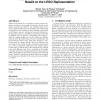Free Online Productivity Tools
i2Speak
i2Symbol
i2OCR
iTex2Img
iWeb2Print
iWeb2Shot
i2Type
iPdf2Split
iPdf2Merge
i2Bopomofo
i2Arabic
i2Style
i2Image
i2PDF
iLatex2Rtf
Sci2ools
GIS
2010
ACM
2010
ACM
Supporting 3D route planning in indoor space based on the LEGO representation
With the prevalence of car navigation systems, indoor navigation systems are increasingly attracting attention in the indoor research area. However, the available models for indoor navigation suffer from the problems that architectural constraints are not considered, route planning is only based on 2D planes, users are represented as points without considering their volumes, and different requirements asked for by different users are ignored. Consequently, the routes provided by existing models may not be suitable for different kinds of users like pedestrians, persons in wheelchairs, and persons driving indoor autos. This paper proposes a cubebased model to compute feasible routes for different users according to their widths, heights, and special requirements (e.g., users in wheelchairs prefer the routes without stairs). In this model, an indoor space is first represented by multiple cubes with different types. Then, according to the heights and types of the cubes, possible passages ...
| Added | 17 May 2011 |
| Updated | 17 May 2011 |
| Type | Journal |
| Year | 2010 |
| Where | GIS |
| Authors | Wenjie Yuan, Markus Schneider |
Comments (0)

